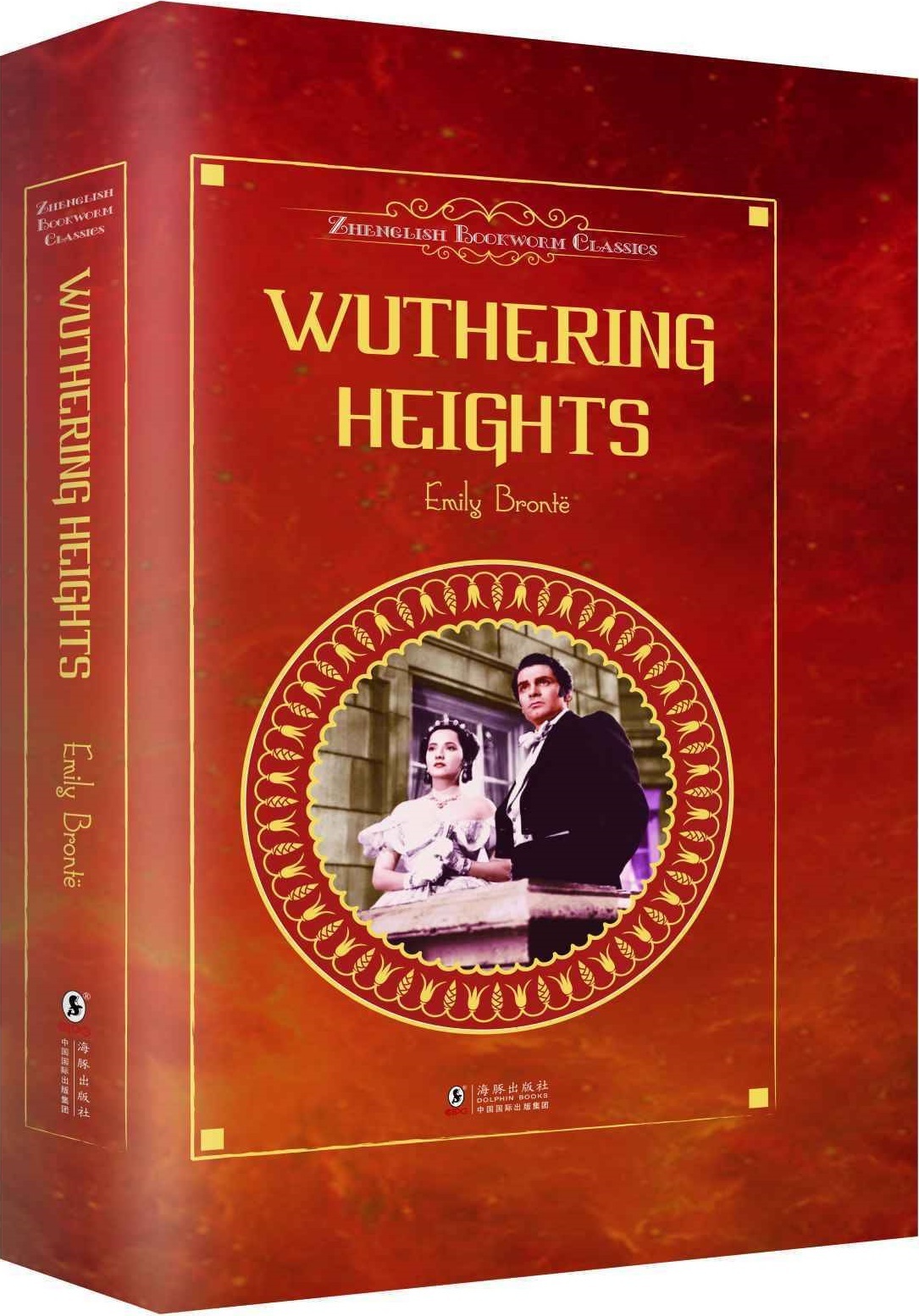

<< 滑动查看下一张图片 >>
目录
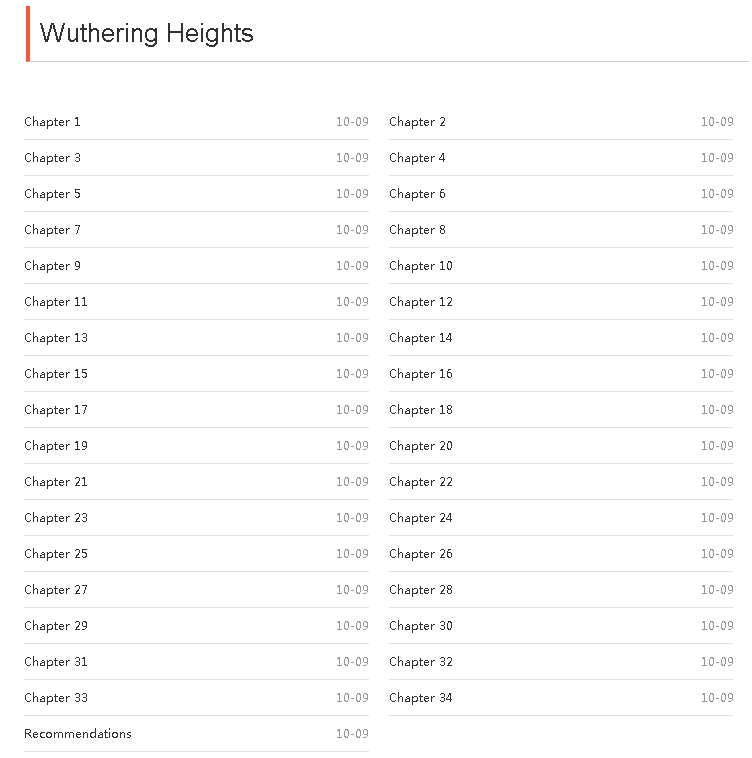
世界村·数字图书馆
官网:Book.yuyang.org
扫二维码下载电子书

★ 相关下载 ★
中文 | 追风筝的人 |
英文 | The Kite Runner |
内容简介
There are few more convincing, less sentimental accounts of passionate love than V/uthering Heights. This is the story of the savage, tormented foundling Heatheliff, who falls wildly in love with Catherine Earnshaw, the daughter of his benefactor, and of the violence and misery that result from their thwarted longing for each other. A book of great power and strength, it is filled with the raw beauty of the moors and an uncanny un- derstanding of the terrible truths about men and women. It is an understanding made even more extraordinary by the fact that it came from the heart of a woman who lived most of her brief life in the remote wildness of the moors. Emily Bronte died a year after this great novel was published。
Characters
Heathcliff: Found, presumably orphaned, on the streets of Liverpool and taken by Mr. Earnshaw to Wuthering Heights, where he is reluctantly cared for by the family. He and Catherine grow close, and their love is the central theme of the first volume. His revenge against the man she chooses to marry and its consequences are the central theme of the second volume. Heathcliff has been considered a Byronic hero, but critics have pointed out that he reinvents himself at various points, making his character hard to fit into any single type. He has an ambiguous position in society, and his lack of status is underlined by the fact that "Heathcliff" is both his given name and his surname.
Catherine Earnshaw: First introduced to the reader after her death, through Lockwood's discovery of her diary and carvings. The description of her life is confined almost entirely to the first volume. She seems unsure whether she is, or wants to become, more like Heathcliff, or aspires to be more like Edgar. Some critics have argued that her decision to marry Edgar Linton is allegorically a rejection of nature and a surrender to culture, a choice with unfortunate, fateful consequences for all the other characters.
Edgar Linton: Introduced as a child in the Linton family, he resides at Thrushcross Grange. Edgar's style and manners are in sharp contrast to those of Heathcliff, who instantly dislikes him, and of Catherine, who is drawn to him. Catherine marries him instead of Heathcliff because of his higher social status, with disastrous results to all characters in the story.
Nelly Dean: The main narrator of the novel, Nelly is a servant to three generations of the Earnshaws and two of the Linton family. Humbly born, she regards herself nevertheless as Hindley's foster-sister (they are the same age and her mother is his nurse). She lives and works among the rough inhabitants of Wuthering Heights but is well-read, and she also experiences the more genteel manners of Thrushcross Grange. She is referred to as Ellen, her given name, to show respect, and as Nelly among those close to her. Critics have discussed how far her actions as an apparent bystander affect the other characters and how much her narrative can be relied on.
Isabella Linton: Is seen only in relation to other characters. She views Heathcliff romantically, despite Catherine's warnings, and becomes an unwitting participant in his plot for revenge against Edgar. Heathcliff marries her but treats her abusively. While pregnant, she escapes to London and gives birth to a son, Linton.
Hindley Earnshaw: Catherine's elder brother, Hindley, despises Heathcliff immediately and bullies him throughout their childhood before his father sends him away to college. Hindley returns with his wife, Frances, after Mr Earnshaw dies. He is more mature, but his hatred of Heathcliff remains the same. After Frances's death, Hindley reverts to destructive behaviour and ruins the Earnshaw family by drinking and gambling to excess. Heathcliff beats Hindley up at one point after Hindley fails in his attempt to kill Heathcliff with a pistol.
Hareton Earnshaw: The son of Hindley and Frances, raised at first by Nelly but soon by Heathcliff. Joseph works to instill a sense of pride in the Earnshaw heritage (even though Hareton will not inherit Earnshaw property, because Hindley has mortgaged it to Heathcliff). Heathcliff, in contrast, teaches him vulgarities as a way of avenging himself on Hindley. Hareton speaks with an accent similar to Joseph's, and occupies a position similar to that of a servant at Wuthering Heights, unaware that he has been done out of his inheritance. In appearance, he reminds Heathcliff of his aunt, Catherine.
Cathy Linton: The daughter of Catherine and Edgar, a spirited and strong-willed girl unaware of her parents' history. Edgar is very protective of her and as a result she is eager to discover what lies beyond the confines of the Grange. Although one of the more sympathetic characters of the novel, she is also somewhat snobbish towards Hareton and his lack of education.
Linton Heathcliff: The son of Heathcliff and Isabella. A weak child, his early years are spent with his mother in the south of England. He learns of his father's identity and existence only after his mother dies, when he is twelve. In his selfishness and capacity for cruelty he resembles Heathcliff; physically, he resembles his mother. He marries Cathy Linton because his father, who terrifies him, directs him to do so, and soon after he dies from a wasting illness associated with tuberculosis.
Joseph: A servant at Wuthering Heights for 60 years who is a rigid, self-righteous Christian but lacks any trace of genuine kindness or humanity. He speaks a broad Yorkshire dialect and hates nearly everyone in the novel.
Mr Lockwood: The first narrator, he rents Thrushcross Grange to escape society, but in the end decides society is preferable. He narrates the book until Chapter 4, when the main narrator, Nelly, picks up the tale.
Frances: Hindley's ailing wife and mother of Hareton Earnshaw. She is described as somewhat silly and is obviously from a humble family.
Mr and Mrs Earnshaw: Catherine's and Hindley's father, Mr Earnshaw is the master of Wuthering Heights at the beginning of Nelly's story and is described as an irascible but loving and kind-hearted man. He favours his adopted son, Heathcliff, which causes trouble in the family. In contrast, his wife mistrusts Heathcliff from their first encounter.
Mr and Mrs Linton: Edgar's and Isabella's parents, they educate their children in a well-behaved and sophisticated way. Mr Linton also serves as the magistrate of Gimmerton, as his son does in later years.
Dr Kenneth: The longtime doctor of Gimmerton and a friend of Hindley's who is present at the cases of illness during the novel. Although not much of his character is known, he seems to be a rough but honest person.
Zillah: A servant to Heathcliff at Wuthering Heights during the period following Catherine's death. Although she is kind to Lockwood, she doesn't like or help Cathy at Wuthering Heights because of Cathy's arrogance and Heathcliff's instructions.
Mr Green: Edgar's corruptible lawyer who should have changed Edgar's will to prevent Heathcliff from gaining Thrushcross Grange. Instead, Green changes sides and helps Heathcliff to inherit Grange as his property.
Family relationships map
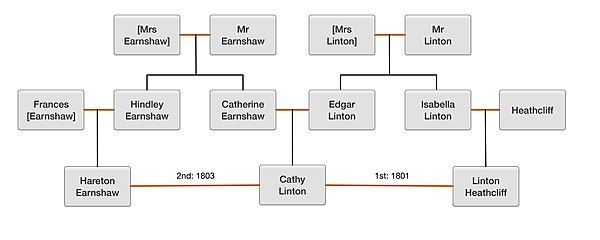
Gothic novel
Ellen Moers, in Literary Women, developed a feminist theory that connects women writers, including Emily Brontë, with gothic fiction. Catherine Earnshaw has been identified by some critics as a type of gothic demon, because she "shape-shifts" in order to marry Edgar Linton, by assuming a domesticity that is contrary to her true nature. It has also been suggested that Catherine's relationship with Heathcliff conforms to the "dynamics of the Gothic romance, in that the woman falls prey to the more or less demonic instincts of her lover, suffers from the violence of his feelings, and at the end is entangled by his thwarted passion".
At one stage Heathcliff is described as a vampire, and it has been suggested that both he and Catherine are in fact meant to be seen as vampire-like personalities.
Publication
1847 edition
The original text, as published by Thomas Cautley Newby in 1847, is available online in two parts. The novel was first published together with Anne Brontë's Agnes Grey in a three-volume format: Wuthering Heights occupied the first two volumes, while Agnes Grey made up the third.
1850 edition
In 1850, when a second edition of Wuthering Heights was due, Charlotte Brontë edited the original text, altering punctuation, correcting spelling errors and making Joseph's thick Yorkshire dialect less opaque. Writing to her publisher, W.S. Williams, she mentioned that "It seems to me advisable to modify the orthography of the old servant Joseph's speeches; for though, as it stands, it exactly renders the Yorkshire dialect to a Yorkshire ear, yet I am sure Southerns must find it unintelligible; and thus one of the most graphic characters in the book is lost on them." An essay written by Irene Wiltshire on dialect and speech in the novel examines some of the changes Charlotte made.
Inspiration for locations
There are several theories about which real building or buildings (if any) may have inspired Wuthering Heights. One common candidate is Top Withens, a ruined farmhouse in an isolated area near the Haworth Parsonage, although its structure does not match that of the farmhouse described in the novel. Top Withens was first suggested as the model by Ellen Nussey, a friend of Charlotte Brontë, to Edward Morison Wimperis, an artist who was commissioned to illustrate the Brontë sisters' novels in 1872.
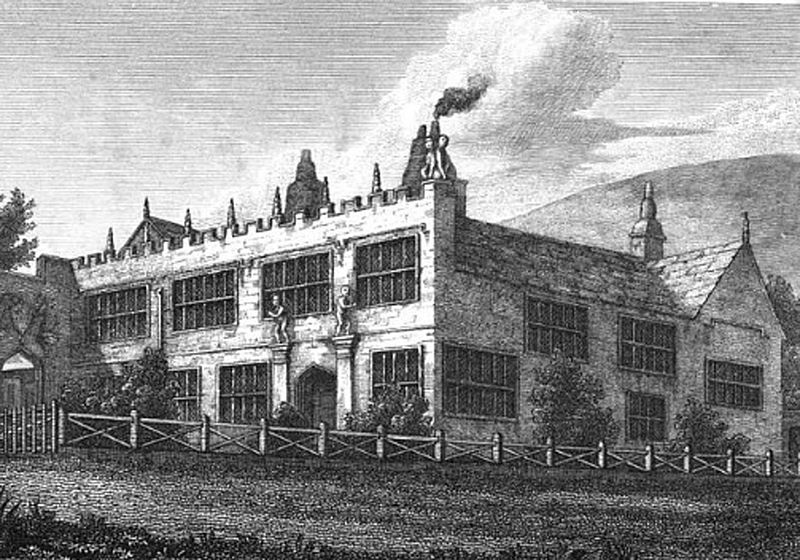
High Sunderland Hall in 1818, shortly before Emily Brontë saw the building.
The second possibility is High Sunderland Hall, near Halifax, now demolished. This Gothic edifice was located near Law Hill, where Emily worked briefly as a governess in 1838. While it was perhaps grander than Wuthering Heights, the hall had grotesque embellishments of griffins and misshapen nude males similar to those described by Lockwood in Chapter 1 of the novel.
The inspiration for Thrushcross Grange has long been traced to Ponden Hall, near Haworth, which is very small. Shibden Hall, near Halifax, is perhaps more likely. The Thrushcross Grange that Emily describes is rather unusual. It sits within an enormous park, as does Shibden Hall. By comparison, the park at Chatsworth (the home of the Duke of Devonshire) is over two miles (3.2 km) long but, as the house sits near the middle, it is no more than a mile and a half (2.4 km) from the lodge to the house. Considering that Edgar Linton apparently does not even have a title, this seems unlikely. There is no building close to Haworth that has a park anywhere near this size, but there are a few houses that might have inspired some elements. Shibden Hall has several features that match descriptions in the novel.
Critical response
Early reviews (1847–1848)
Early reviews of Wuthering Heights were mixed in their assessment. While most critics at the time recognised the power and imagination of the novel, they were also baffled by the storyline and found the characters prone to savagery and selfishness. Published in 1847, at a time when the background of the author was deemed to have an important impact on the story itself, many critics were also intrigued by the authorship of the novels.[citation needed]Henry Chorley of the Athenæum said that it was a "disagreeable story" and that the "Bells" (Brontës) "seem to affect painful and exceptional subjects".
The Atlas review called it a "strange, inartistic story," but commented that every chapter seems to contain a "sort of rugged power." Atlas summarised the novel by writing: "We know nothing in the whole range of our fictitious literature which presents such shocking pictures of the worst forms of humanity. There is not in the entire dramatis persona, a single character which is not utterly hateful or thoroughly contemptible ... Even the female characters excite something of loathing and much of contempt. Beautiful and loveable in their childhood, they all, to use a vulgar expression, "turn out badly"."
Graham's Lady Magazine wrote "How a human being could have attempted such a book as the present without committing suicide before he had finished a dozen chapters, is a mystery. It is a compound of vulgar depravity and unnatural horrors."
The American Whig Review wrote "Respecting a book so original as this, and written with so much power of imagination, it is natural that there should be many opinions. Indeed, its power is so predominant that it is not easy after a hasty reading to analyze one's impressions so as to speak of its merits and demerits with confidence. We have been taken and carried through a new region, a melancholy waste, with here and there patches of beauty; have been brought in contact with fierce passions, with extremes of love and hate, and with sorrow that none but those who have suffered can understand. This has not been accomplished with ease, but with an ill-mannered contempt for the decencies of language, and in a style which might resemble that of a Yorkshire farmer who should have endeavored to eradicate his provincialism by taking lessons of a London footman. We have had many sad bruises and tumbles in our journey, yet it was interesting, and at length we are safely arrived at a happy conclusion."
Douglas Jerrold's Weekly Newspaper wrote "Wuthering Heights is a strange sort of book,—baffling all regular criticism; yet, it is impossible to begin and not finish it; and quite as impossible to lay it aside afterwards and say nothing about. In Wuthering Heights the reader is shocked, disgusted, almost sickened by details of cruelty, inhumanity, and the most diabolical hate and vengeance, and anon come passages of powerful testimony to the supreme power of love – even over demons in the human form. The women in the book are of a strange fiendish-angelic nature, tantalising, and terrible, and the men are indescribable out of the book itself. Yet, towards the close of the story occurs the following pretty, soft picture, which comes like the rainbow after a storm ... We strongly recommend all our readers who love novelty to get this story, for we can promise them that they never have read anything like it before. It is very puzzling and very interesting, and if we had space we would willingly devote a little more time to the analysis of this remarkable story, but we must leave it to our readers to decide what sort of book it is."
New Monthly Magazine wrote "Wuthering Heights, by Ellis Bell, is a terrific story, associated with an equally fearful and repulsive spot ... Our novel reading experience does not enable us to refer to anything to be compared with the personages we are introduced to at this desolate spot – a perfect misanthropist's heaven."
Tait's Edinburgh Magazine wrote "This novel contains undoubtedly powerful writing, and yet it seems to be thrown away. Mr. Ellis Bell, before constructing the novel, should have known that forced marriages, under threats and in confinement are illegal, and parties instrumental thereto can be punished. And second, that wills made by young ladies' minors are invalid. The volumes are powerfully written records of wickedness and they have a moral – they show what Satan could do with the law of Entail."
Examiner wrote "This is a strange book. It is not without evidences of considerable power: but, as a whole, it is wild, confused, disjointed, and improbable; and the people who make up the drama, which is tragic enough in its consequences, are savages ruder than those who lived before the days of Homer."
Literary World wrote "In the whole story not a single trait of character is elicited which can command our admiration, not one of the fine feelings of our nature seems to have formed a part in the composition of its principal actors. In spite of the disgusting coarsness of much of the dialogue, and the improbabilities of much of the plot, we are spellbound."
Britannia called it a "strangely original" book that depicts "humanity in this wild state." Although mostly hostile, it notes that the book is "illuminated by some gleams of sunshine towards the end which serve to cast a grateful light on the dreary path we have traveled."
G.H. Lewes, in Leader, shortly after Emily's death, wrote: "Curious enough is to read Wuthering Heights and The Tenant of Wildfell Hall, and remember that the writers were two retiring, solitary, consumptive girls! Books, coarse even for men, coarse in language and coarse in conception, the coarseness apparently of violence and uncultivated men – turn out to be the productions of two girls living almost alone, filling their loneliness with quiet studies, and writing their books from a sense of duty, hating the pictures they drew, yet drawing them with austere conscientiousness! There is matter here for the moralist or critic to speculate on".
Adaptations
The earliest known film adaptation of Wuthering Heightswas filmed in England in 1920 and was directed by A. V. Bramble. It is unknown if any prints still exist.[33] The most famous is 1939's Wuthering Heights, starring Laurence Olivier and Merle Oberon and directed by William Wyler. This acclaimed adaptation, like many others, eliminated the second generation's story (young Cathy, Linton and Hareton) and is rather inaccurate as a literary adaptation. It won the 1939 New York Film Critics Circle Award for Best Film and was nominated for the 1939 Academy Award for Best Picture.
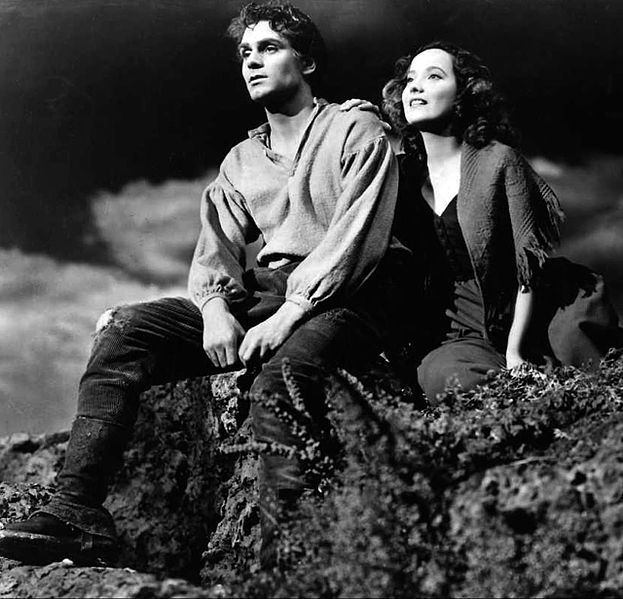
Laurence Olivier and Merle Oberon in the 1939 film Wuthering Heights
In 1967, the BBC produced a dramatisation starring Ian McShane and Angela Scoular.
The 1970 film with Timothy Dalton as Heathcliff is the first colour version of the novel. It has gained acceptance over the years although it was initially poorly received. The character of Hindley is portrayed much more sympathetically, and his story-arc is altered. It also subtly suggests that Heathcliff may be Cathy's illegitimate half-brother.
In 1978, the BBC produced a five-part TV serialisation of the book starring Ken Hutchinson, Kay Adshead and John Duttine, with music by Carl Davis; it is considered one of the most faithful adaptations of Emily Brontë's story.
There is also a 1985 French film adaptation, Hurlevent by Jacques Rivette.
The 1992 film Emily Brontë's Wuthering Heights starring Ralph Fiennes and Juliette Binoche is notable for including the oft-omitted second generation story of the children of Cathy, Hindley and Heathcliff.
More recent film or TV adaptations include ITV's 2009 two-part drama series starring Tom Hardy, Charlotte Riley, Sarah Lancashire, and Andrew Lincoln, and the 2011 film starring Kaya Scodelario and James Howson and directed by Andrea Arnold.
Adaptations which place the story in a new setting include the 1953 adaptation, retitled Abismos de Pasion, directed by Spanish filmmaker Luis Buñuel and set in Catholic Mexico, with Heathcliff and Cathy renamed Alejandro and Catalina. In Buñuel's version Heathcliff/Alejandro claims to have become rich by making a deal with Satan. The New York Times reviewed a re-release of this film as "an almost magical example of how an artist of genius can take someone else's classic work and shape it to fit his own temperament without really violating it," noting that the film was thoroughly Spanish and Catholic in its tone while still highly faithful to Brontë. Yoshishige Yoshida's 1988 adaptation also has a transposed setting, this time to medieval Japan. In Yoshida's version, the Heathcliff character, Onimaru, is raised in a nearby community of priests who worship a local fire god. Filipino director Carlos Siguion-Reyna made a film adaptation titled Hihintayin Kita sa Langit (1991). The screenplay was written by Raquel Villavicencio. It starred Richard Gomez as Gabriel (Heathcliff) and Dawn Zulueta as Carmina (Catherine). It became a Filipino film classic. In 2003, MTV produced a poorly reviewed version set in a modern California high school.
The 1966 Indian film Dil Diya Dard Liya is based upon this novel. The film is directed by Abdul Rashid Kardar and Dilip Kumar. The film stars the thespian Dilip Kumar, Waheeda Rehman, Pran, Rehman, Shyama and Johnny Walker. The music is by the legendary composer Naushad. Although it did not fare as well as other movies of Dilip Kumar, it was well received by critics.
The novel has been popular in opera and theatre, including operas written by Bernard Herrmann, Carlisle Floyd, and Frédéric Chaslin (most cover only the first half of the book) and a musical by Bernard J. Taylor.
In 2011, a graphic novel version was published by Classical Comics. It was adapted by Scottish writer Sean Michael Wilson and hand painted by comic book veteran artist John M Burns. This version, which stays close to the original novel, received a nomination for the Stan Lee Excelsior Awards, elected by pupils from 170 schools in the United Kingdom.
Works inspired
In her 2019 novel,The West Indian, Valerie Browne Lester imagines an origin story for Heathcliff in 1760s Jamaica.
Kate Bush's song "Wuthering Heights" is most likely the best-known creative work inspired by Brontë's story that is not properly an "adaptation". Bush wrote and released the song when she was 18 and chose it as the lead single in her debut album (despite the record company preferring another track as the lead single). It was primarily inspired by the Olivier–Oberon film version, which deeply affected Bush in her teenage years. The song is sung from Catherine's point of view as she pleads at Heathcliff's window to be admitted. It uses quotations from Catherine, both in the chorus ("Let me in! I'm so cold!") and the verses, with Catherine's admitting she had "bad dreams in the night". Critic Sheila Whiteley wrote that the ethereal quality of the vocal resonates with Cathy's dementia, and that Bush's high register has both "childlike qualities in its purity of tone" and an "underlying eroticism in its sinuous erotic contours". Singer Pat Benatar also released the song in 1980 on the "Crimes of Passion" album.
Wind & Wuthering (1976) by English rock band Genesisalludes to the Brontë novel not only in the album's title but also in the titles of two of its tracks, "Unquiet Slumbers for the Sleepers..." and "...In That Quiet Earth". Both titles refer to the closing lines in the novel.
Songwriter Jim Steinman said that he wrote the song "It's All Coming Back to Me Now" "while under the influence of Wuthering Heights". He said that the song was "about being enslaved and obsessed by love" and compared it to "Heathcliffe digging up Kathy's corpse and dancing with it in the cold moonlight".
The song "Cath" by indie rock band Death Cab for Cutiewas inspired by Wuthering Heights.
The poem "Wuthering" (2017) by Tanya Grae uses Wuthering Heights as an allegory.
Maryse Condé's Windward Heights (La migration des coeurs, published in 1995; English translation published in 1998) is a reworking of Wuthering Heights set in Cuba and Guadaloupe at the turn of the 20th century, which Condé stated she intended as an homage to Brontë.
Mizumura Minae's A True Novel (Honkaku shosetsu, published in 2002 by Shinchosha; English translation by Juliet Winters Carpenter published by Other Press in 2013) is inspired by Wuthering Heights and might be called an adaptation of the story in a post-World War II Japanese setting.
In Jane Urquhart's Changing Heaven, the novel Wuthering Heights, as well as the ghost of Emily Brontë, feature as prominent roles in the narrative.
The song "Cover My Eyes (Pain and Heaven)" by the band Marillion includes the line "Like the girl in the novel in the wind on the moors".
The song "Emily" by folk artist Billie Marten is written from Brontë's perspective. Marten wrote the song while studying Wuthering Heights.
Canadian author Hilary Scharper's ecogothic novel Perdita(2013) was deeply influenced by Wuthering Heights,namely in terms of the narrative role of powerful, cruel and desolate landscapes.
The song "Wuthering Heights" by EURINGER was inspired by Wuthering Heights.